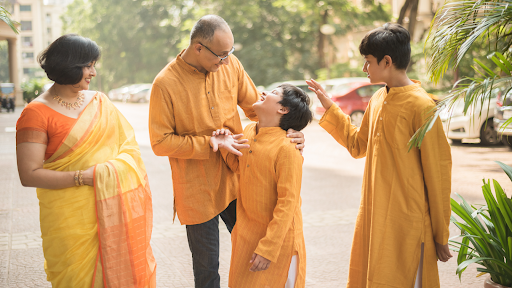Indian Traditional Attires

A major part of North India like Jammu and Kashmir, Himachal Pradesh, and Uttaranchal experience extreme cold climates most of the year, which requires proper clothing. In Jammu and Kashmir colorful Pherans and Shawls are worn by women, which are popular for the intricate embroidery styles and the stuff they are made of.
It is said that a Kashmiri dress is incomplete without the accessories that comprise Kashmiri earrings known as Jhumkis or Chand-baale. The men wear long robes made of pure wool known as Gouache, which is tightened at the waist. They wear long boots made of animal skin which keep their feet warm to manage the extreme cold.
In Haryana, women wear short Ghaghras or skirts, Kurtis and Chunder or Chunris to go well with Haryana Dress them. These Chunders are available in various colors and are tucked with laces and are used by women to cover their faces, also called as ‘Riwaaz’
The men wear Dhoti, Kurta, and Pagri. Holding their Lachi, they look typical Haryanvi. The Pagri or headgear is usually the same but is tied and worn in different ways by people of different regions and that makes it look different. Apart from these, the usual lehengas and ghagras, and laches are also worn.
Clothing in Western India:
Rajasthan DressThe western region of India comprises Rajasthan and Gujarat which experience very hot and dry summers and chilly winters. Unlike the somber and sandy backdrop, the amazing mirror, bead, and stonework on them make them dazzle reflecting a wide array of colors.
Rajasthani women also wear Bandhini tie-n-dye sarees. The Dress of North INdiawear head to toe ornaments like Maang-teeka, Matha-Patti, Rakhi or Ghundi for forehead, Kanthi for the neck area, Pajeb or anklets, Arsi or ring, and Kanghan or bangles. These jewelry items are either made of gold, silver, or brass.
The Kundan and Lac jewelry of Rajasthan is quite popular. The men wear Dhoti, Portia, Angrakha, Banda, Dhabla, Pachewara, and Bugatti. The most essential part of clothing is that headdress or turban or Pancha or Safa, tied uniquely.
Dress from GujaratIn rural parts of Gujarat, the men wear cotton-made Chrono or shorts that are worn as lower and Angarakhu as the upper clothing. Along with this, they wear a thickly folded turban that is called Fenton. Women wear the heavily embroidered Chaniyo and the equally embroidered bodice known as Choli. They cover their head and upper body with Odhni the colored piece of cloth.
They also wear saris in colorful Gujarati prints. Males wear Dhoti, coat, and turban. Ornaments worn both by males and females include kanthi round the neck, pandora at the waist, and vinti worn on fingers. They are usually made of silver.
Maharashtrian men wear Dhoti and shirts along with the headgear Pheta or Patka or Rumal. The women wear a typical Maharashtrian sari known as Luggage with a mega-sleeved Choli or blouse. They get that traditional Marathi look by wearing the typical Nathni or nose ring.
Costumes of East and North-East India:
Traditional Bengali women wear a white saree with a red border, especially during festivals or special occasions. The men wear dhoti-kurta which is again the traditional attire of Bengal though most men of today hardly know how to wear one!
The traditional costumes of north-east India comprising Assam, Meghalaya, Mizoram, Manipur, and Costumes of North East IndiaTripura, Nagaland, and Arunachal Pradesh, are far different from that of the rest of Indian clothes. They also wear the three-piece dress known as Mekhla Chador.
There are many tribals in Arunachal Pradesh. The Buddhist Monpas women wear chemise and a jacket over it with a printed fabric over the waist. The women of the Naga tribe wear a lovely woven petticoat and a blouse.
Manipuri women wear Innaphi the shawl, a wrap-around called Panek, and a hard-stuff skirt called Sarong. During the festive season, for bridals and dance performances, the women wear Potlois.
In Meghalaya, the Garo tribal women wear an unstitched cloth known as Jensen and a wrap-around. They wear the lovely Endi shawls which are quite popular for the fine work done on them.
Traditional dress of MizoramThe Mizo woman wears a bright-colored Puan that looks like a regular churidar-kurta. For weddings, they wear Puanchei. They wear head-dress in dance performances. The Hallam, Khalkloo, Lushei, and Kuki-Chin wear lovely woven clothes. The Khakloo tribe wears Rinnai a draped cloth around the waist, along with Risa worn in the upper part.
Clothing Styles of South India:
The traditional dresses of Indian women in Kerala are white-colored silk sari with a broad golden zari border. Men wear Shirts, Lungis, or short Kurtas. On special occasions, they wear Mundu and Neriathu which match with the female costume in white color and golden zari border.
There are many tribals in Karnataka and the attire they are found in depicts their love and Dress of South Indiaexperimentation with colors. Men wear Lungis and a shirt along with a piece of silk or cotton cloth known as Angavastram that is kept casually on their neck, covering the shoulder area.
Women wear Saris of various color combinations. The look of the sari depends upon the way it is draped. The Kodava women in the state wear sari different uniquely with pleats at the back.
Women in South India wear Kanchipuram silk sarees with beautiful bright borders and gold work.
The definitive artwork on the fabrics makes Indian costumes unique from others.


